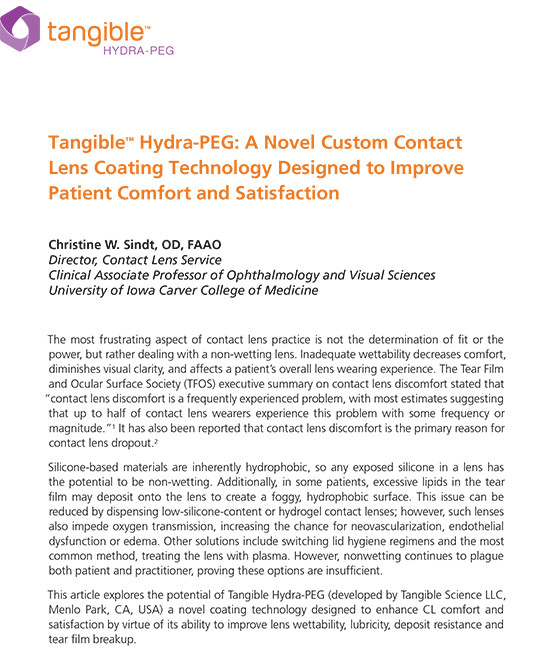Tangible™ Hydra-PEG: A Novel Custom Contact Lens Coating Technology Designed to Improve Patient Co
White Paper by:
Christine W. Sindt, OD, FAAO
Director, Contact Lens Service
Clinical Associate Professor of Ophthalmology and Visual Sciences
University of Iowa Carver College of Medicine
The most frustrating aspect of contact lens practice is not the determination of fit or the power, but rather dealing with a non-wetting lens. Inadequate wettability decreases comfort, diminishes visual clarity, and affects a patient’s overall lens wearing experience. The Tear Film and Ocular Surface Society (TFOS) executive summary on contact lens discomfort stated that “contact lens discomfort is a frequently experienced problem, with most estimates suggesting that up to half of contact lens wearers experience this problem with some frequency or magnitude.”1 It has also been reported that contact lens discomfort is the primary reason for contact lens dropout.2
Silicone-based materials are inherently hydrophobic, so any exposed silicone in a lens has the potential to be non-wetting. Additionally, in some patients, excessive lipids in the tear film may deposit onto the lens to create a foggy, hydrophobic surface. This issue can be reduced by dispensing low-silicone-content or hydrogel contact lenses; however, such lenses also impede oxygen transmission, increasing the chance for neovascularization, endothelial dysfunction or edema. Other solutions include switching lid hygiene regimens and the most common method, treating the lens with plasma. However, nonwetting continues to plague both patient and practitioner, proving these options are insufficient.
This article explores the potential of Tangible Hydra-PEG (developed by Tangible Science LLC, Menlo Park, CA, USA) a novel coating technology designed to enhance CL comfort and satisfaction by virtue of its ability to improve lens wettability, lubricity, deposit resistance and tear film breakup.
Click here to read the complete white paper.

